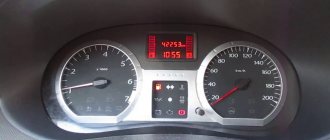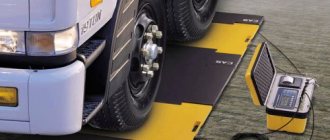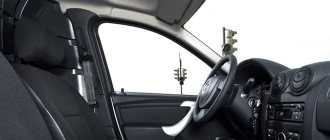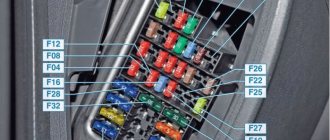The information is intended for use by service station employees. The above data is systematized using official directories of vehicle manufacturers. This information is for reference only and may vary depending on your specific vehicle. If you are unsure, refer to the vehicle manufacturer's additional documentation and information plates. We are not responsible for the use of this information when refilling the air conditioner. All work on refilling the air conditioning system must be carried out by specially trained personnel using certified equipment. Posting this information in other sources is permissible without the consent of the owner of this site, but with a link to it.
Back call
Everything you need to know about auto air conditioner repair Hello.
Finally, through the efforts of the main leader himself, a month-long weekend has arrived and the opportunity has arisen to describe all the specifics of our work. The difficulty... Read more » Diagnostics of a car air conditioner Hello. I am glad that you have visited the most rarely visited page on our website. Unfortunately, the average level of car user... Read more » Replacing a compressor bearing The service life of modern cars is about two hundred thousand kilometers. This axiom has been proven by many automakers. The main method of pumping money out of owners is... Read more » Repairing a car air conditioning tube A modern car requires more than just gasoline or spare parts. He needs constant care and careful care. This truism, first of all,... Read more » Repair of rear air conditioner tubes of a Volkswagen T5 Time and salt do not spare anyone. Another T5 Multivan arrived for air conditioner repair. The problem, as always, came from a well-known place... Read more » Attention. When carrying out any type of work on the car related to depressurization of the air conditioning system, completely unload the refrigerant and then reload the system in the required volume (see below).
UNLOADING (REMOVING) REFRIGERANT
Attention. Work on unloading the refrigerant should be carried out in accordance with the operating instructions for the service equipment.
Unscrew the cap on any of the 2 fittings (you must work with gloves)
Press the valve spool with a suitable thin tool to release the refrigerant from the system.
This work must be done outdoors. When releasing the refrigerant, do not rush, then it will have time to evaporate. Keep in mind that some oil may splash, so stock up on cleaning material.
Before loading the refrigerant, it is necessary to evacuate the air conditioning system in accordance with the operating instructions for the service equipment.
Attention. Work on loading refrigerant should be carried out in accordance with the operating instructions for service equipment.
| Figure 4-1 — Filling the air conditioning system with refrigerant: 1 — high pressure circuit fitting; 2 - low pressure circuit fitting |
Attention. When the engine is not running, refrigerant is charged through the high-pressure circuit, Figure 4-1. If the system is not fully loaded with refrigerant, reload with the engine running and the air conditioning system turned on through the low pressure circuit with gaseous refrigerant.
The mass of the refrigerant charged into the system (R134a, also known as HFC-134a freon) is 475 ± 35 g. Special SP10 oil has been added to the refrigerant to lubricate the compressor. It is strictly prohibited to use other types of refrigerants and oils in the system.
CHECKING FOR REFRIGERANT LEAKS
Attention. Work to detect refrigerant leaks should be carried out in accordance with the operating instructions for the leak detector.
The use of freon in air conditioning systems is due to the fact that during evaporation it absorbs heat and then releases it during condensation. This is the principle on which all air conditioners operate.
Working principle of a car cooler
It is impossible to properly service a car’s air conditioner without knowing its structure and operating principle. The climate control system includes the following elements and units:
- external heat exchanger (condenser), installed next to the radiator of the engine cooling system;
- internal heat exchanger (evaporator), mounted in the cabin air duct;
- the fins of both heat exchangers are forcedly blown by fans;
- the compressor, which creates the necessary freon pressure in the circuit, is driven by a belt drive from the crankshaft;
- expansion valve, gas dryer;
- connecting freon lines made of copper tubes.
Key moment! The operating principle of any air conditioner is based on the ability of the refrigerant to evaporate at sub-zero temperatures. At the moment of evaporation, freon quickly removes a large amount of heat from the air, significantly reducing its temperature.
To properly charge a car air conditioner, you need to imagine the operating cycle of the air conditioning system:
- While in a liquid state, the refrigerant is supplied to the evaporator, through which a fan drives hot air. Freon evaporates, takes away heat from the flow and is sent further - to the compressor.
- Inside the blower, the gas is compressed and moved to an external heat exchanger. The boiling point of a substance under pressure increases, so the freon in the external radiator condenses and releases the accumulated heat to the outside air.
- After flowing through the dryer and expansion valve, the refrigerant pressure drops again. The gas again moves into the internal heat exchanger to evaporate and go through the cycle again.
Nominal filling volumes
Lada Vesta. Nominal filling volumes, l
| Unit | Volume, l |
| Fuel tank | 50 |
| Engine lubrication system | |
| -21129 (oil sump by league) | 4,4 (4,1)* |
| 21129 (stamped oil sump) | 3,2 (2,9)* |
| – 21179 (cast oil sump) | 4,4 (4,1)* |
| Engine cooling and interior heating system** | |
| -21179/21129 | 7,0 (6,4) |
| Transmission: | |
| – AMT 2182 | 2,25±0,05*** |
| -MT 2180 | 2,25+0,05*** |
| -MTJh4 | 2,34*** |
| Hydraulic clutch and brake system | 0,559 |
| Hydraulic brake system (for versions with AMT) | 0,517 |
| Windshield washer reservoir | 4,7 |
| Expansion tank (included with engine 21129) | 5.75 (max) – 5.35 (min) |
| Ozone-safe freon R1234yF in the air conditioning system, kg | 0,475±0,02 |
When changing the oil (with replacing the oil filter).
* * The use of mixtures of coolants of different brands is not allowed.
Reference value! The oil level should be at the lower edge of the filler hole.
Reference value!
Lada Vesta. Fuel
Only unleaded gasoline with research octane numbers of 92, 95 and 98 units of the following brands are allowed for use: “Regular Euro-92”, “Premium Euro-95”. “Super Euro-98” according to GOST R 51866-2002 or “AI-92-K5 (K4)”, “AI-95-K5 (K4)”; "AI-98-K5 (K4)" according to GOST 32513-2013. The preferred fuel for your car is gasoline with an octane rating of 95. This gasoline allows you to achieve the rated values of power, dynamics, efficiency and toxicity. If it is not possible
When using gasoline with an octane number of 95, it is allowed to use gasoline with an octane number of at least 92.
Lada Vesta. Engine oil
In Table 1 below, determine the quality level and viscosity class of the oil prescribed for your vehicle in accordance with the available operating temperature range. If necessary, change the oil. To do this, contact an authorized service center.
Table 1
Lada Vesta. Oil quality level and viscosity class
Use only recommended operating and lubricating fluids. Consult your dealer for recommended operating and lubricating fluids.
table 2
Lada Vesta. Spark plug
| Engine | Spark plug | Gap, mm | |
| 21129 | 16-valve- ny | AU1 /DVRM Robert Bosch Saratov DR15YC-1 BRISK FR7DCU Bosch | 1 …1,15 |
Signs of freon deficiency
Since the gas pressure in the circuit can reach 20–25 Bar, a natural refrigerant leak of up to 10% is allowed on a used car. If the losses exceed the specified value, the cooling efficiency decreases noticeably - the air conditioner drives warm air.
When faced with a similar problem, arm yourself with the operating instructions for the machine, find the location of the heat exchangers, supply pipes and make sure that secondary signs of gas leakage appear:
- traces or drops of oil at pipeline joints;
- freezing of one or both highways;
- one of the heat exchangers (usually the evaporator) is covered with frost;
- Using a thermometer, measure the air temperature at the outlet of the deflector - it should correspond to the cooler setting.
Reference. Freon contains synthetic or mineral oil to lubricate the compressor. Therefore, at leaky joints, traces of the lubricant component appear first.
Before filling the air conditioner with freon, be sure to identify and repair the leak. Tighten the union nuts with a wrench and check the system for leaks using the only method available in the garage - vacuuming. Read more about this operation below.
About the conventions
Let us remember that the practical Lada Granta model went into production back in 2011. This modern car is full of new modifications of complex instruments and electronic devices. All this aims to provide the driver with maximum driving comfort. Today VAZ produces the Lada Granta in three versions in terms of equipment:
The first two options have the same wiring diagram, but in the “Lux” it is different. It's a shame that the factory operating instructions for the car do not contain this wiring diagram. However, do not rush to get upset, because such an album with the entire list of schemes can be purchased in the market network of auto goods.
Electrical cabling involves the presence of a large number of bundles. The wiring diagram has symbols and serial numbers, each of which is assigned to a strictly specific pantograph. These consumers in the diagram are switched into the general network via conventional lines. To increase clarity, the developers used different colors for the lines. Next, the wires are assembled into bundles, which are connected to electrical units using special connectors.
Article on the topic: What to do if your neighbors’ air conditioner is dripping
Refueling equipment
Service station technicians practice several methods of refueling car air conditioners. For a car enthusiast who is new to garage conditions, only one method is available - a complete replacement with filling in a new portion of refrigerant by weight. To work, you need to rent a set of equipment and accessories:
- vacuum pump equipped with a check valve;
- pressure gauge station with two filling hoses, blue and yellow;
- electronic scales in a floor or tabletop version (kitchen scales are suitable, showing weight with an accuracy of 1 gram);
- adapter for the service port (fitting) of a specific car model;
- oil injector - a small container connected to the filling hose.
Note. The cost of renting a set of equipment used for refilling refrigeration machines starts from 1000 rubles. per day. Refrigerant and oil are purchased separately.
To refill the car air conditioning system yourself, you need to find out the amount and brand of freon being filled. As a rule, this data is contained in the machine’s operating instructions, plus there is a nameplate or sticker under the hood. Two characteristics are indicated - the brand and weight of the refrigerant in the system. Accordingly, you need to buy the required amount of gas, taking into account a reserve of 5–10% for purging and unforeseen losses.
The vast majority of modern vehicles use R134a freon, which replaced the more dangerous and harmful R12 gas . During the process of adding refrigerant using an injector, liquid lubricant for the compressor is dissolved. You will need 30 ml of special polyalkylene glycol oil (abbreviation PAG on the package).
Stage two - filling the system with refrigerant
Before refueling, you need to attach the oil injector to the freon cylinder and pour 30 ml of lubricant into it. Then close the previously open manifold and inlet valves, and disconnect the hose from the vacuum pump.
Important point! The car's coolant circuit must be filled with freon, which is in a liquid state. To fill, the tank should be turned upside down so that the outlet pipe is at the bottom. Then the gas phase will not enter the hose.
Further refueling of the air conditioner with your own hands looks like this:
- Attach the yellow hose to the injector bottle and open the reservoir valve.
- After turning off the vacuum pump, the yellow filling tube filled with air. Its removal is carried out by purging: slightly open the right valve of the pressure gauge station for 1–2 seconds. The refrigerant pressure will push the air out.
- Place the cylinder on the electronic scale with the bottom up and reset the display.
- Open the left valve of the gauge manifold and watch the scale readings. The pressure gauge needle should move in the direction of increasing pressure.
- When the display reads the required amount of gas, close the valve of the service port, manifold and cylinder.
- Start the car engine and check the operation of the air conditioner in cooling mode.
- Bleed freon from the hoses using the same purge - open the right valve of the station. Disconnect the cylinder and all connections, close the fitting with a protective cap.
During the charging process, it sometimes happens that the required amount of refrigerant does not want to flow into the air conditioner circuit on its own. The vacuum created in the system is not enough to draw in the liquid phase of freon. The solution is simple: start the engine, turn on the cooler and wait until the compressor starts. At this moment, the flow will resume; the main thing is to close the tap in a timely manner. The filling rate indicated on the plate must not be exceeded.
Technical characteristics of Lada Vesta
The long-awaited new product in the Russian segment of budget cars - the Lada Vesta sedan - in its overall dimensions is on the border of B and C classes. The length of the car is 4410 mm, width – 1764 mm, height – 1497 mm, wheelbase – 2635 mm. Underbody clearance of 178 mm allows you to confidently move on roads with poor surfaces, be it asphalt riddled with holes or a country dirt road. In addition to high ground clearance, good geometric cross-country ability is ensured by fairly short overhangs: front – 860 mm, rear – 915 mm.
The Lada Vesta engine line includes several gasoline power plants. From the start of sales, the car is offered only with a 1.6-liter engine producing 106 hp. This four-cylinder unit with serial number 21129 is a Russian development and is installed on other AvtoVAZ models, for example, on the same Lada Granta liftback. Later, the sedan’s engine range will be replenished with H4M (1.6 liters, 110 hp) and 21179 (1.8 liters, 122 hp) engines. The first engine is provided by the Renault-Nissan alliance, the second is domestically developed.
Technical characteristics of Lada Vesta engines:
| Parameter | 1.6 106 hp | 1.6 110 hp | 1.8 122 hp |
| Engine code | 21129 | H4M | 21179 |
| engine's type | petrol without turbocharging | ||
| Supply system | distributed injection | ||
| Number of cylinders | 4 | ||
| Cylinder arrangement | in-line | ||
| Number of valves | 16 | ||
| Cylinder diameter, mm | 82.0 | 76.0 | 82.0 |
| Piston stroke, mm | 75.6 | 88.0 | 84.0 |
| Compression ratio | 10.45:1 | 10.7:1 | 10.3:1 |
| Working volume, cubic meters cm. | 1596 | 1598 | 1774 |
| Power, hp (at rpm) | 106 (5800) | 110 (5500) | 122 (5900) |
| Torque, N*m (at rpm) | 148 (4200) | 150 (4000) | 170 (3700) |
| Weight, kg | 105.4 | 92.5 | 109.7 |
It will be useful: What is the trunk volume on a VAZ 2110: technical parameters
Gearboxes are represented by a 5-speed “mechanics” Renault (index JH3) and a 5-speed VAZ “robot”. The manual transmission is based on a manual transmission 2180, which was supplemented with a Valeo clutch and a gear shift mechanism from ZF. The transmission was developed back in 2014, and since then it has been installed on many Tolyatti models.
Technical characteristics of Lada Vesta gearboxes:
| Parameter | 5-speed manual transmission | 5-speed manual transmission | |
| Model | JH3 510 | 21827 | |
| Gear ratio | 1st gear | 3.727 | 3.636 |
| 2nd gear | 2.048 | 1.950 | |
| 3rd gear | 1.393 | 1.357 | |
| 4th gear | 1.029 | 0.941 | |
| 5th gear | 0.795 | 0.784 | |
| Reverse | 3.545 | 3.500 | |
| Weight, kg | 33.0 | 33.1 |
The suspension of the Lada Vesta is arranged according to the classic design: MacPherson struts are installed in front, and a torsion beam is installed in the rear. The rack-and-pinion steering mechanism is equipped with an electric booster.
The luggage compartment of the car boasts a decent volume of 480 liters. It is also possible to tow an unbraked trailer weighing up to 450 kg. If the trailer has brake mechanisms, its weight should not exceed 900 kg.
Fuel consumption of a Lada Vesta with a 106-horsepower engine and manual transmission does not exceed 6.9 liters per 100 km. The modification with a robotic gearbox is more economical - on average it consumes 6.6 liters. In terms of dynamic characteristics, the manual version has an advantage, accelerating to “hundreds” in 11.2 seconds. A car with a “robot” is almost 3 seconds slower.
How much does it cost to refill a car air conditioner?
| Type of work | Cost, Russian rubles |
| Charging the system with refrigerant (evacuation, evacuation, leak test, refilling) | 1500 rub. (excluding refrigerant cost) |
| Refilling the car air conditioner | 900 rub. (excluding refrigerant cost) |
| Refrigerant R-134a | 250 rub. per 100 grams |
| Adding oil to the system | 500 rub. (including oil) |
| UV dye for oil (tracer) | 250 rub. |
| Diagnostics using a leak detector or ultraviolet | 800 rub. |
How much freon is in a car air conditioner?
When for some reason the table is missing, you can also find out how much refrigerant is needed from the car dealer or look in the manual. For Russian cars, the filling rate is usually about 600-900g. Although, in principle, accuracy is by and large not needed, because, as a rule, you refuel the system yourself, and not completely fill the air conditioner. The car air conditioner is refilled either at the factory, or after repair, when the gas is completely out, and during scheduled maintenance, we can only top up the freon to the norm, when it can work at full capacity. But with such a partial charge of the car air conditioner, we cannot know how many grams of freon are left. Therefore, the air conditioner in the car is charged according to the pressure displayed on the pressure gauge. Therefore, if you were unable to find out the exact numbers and determine the amount of freon in the car’s air conditioner, then follow the arrow of the device.
Air conditioner diagnostics
If you find a refrigerant leak through damaged tubes, replace them entirely or visit a specialized workshop for repairs. Do not use adhesives or sealants, they are not durable.
If the radiators are damaged, replace them yourself or contact a specialized workshop. Check the belt tension and compare it with that specified in the machine or air conditioner service instructions. Start the engine, then increase the speed to 1500 rpm. Place your hand around the high pressure outlet (it has thick steel or copper tubing connected to it). If the compressor is working correctly, then after 1-2 minutes the outlet will heat up and your hand will become hot. If your hand burns, the compressor needs to be repaired or replaced. If it is slightly warm, there is too little refrigerant in the system. Place your hand around the cold pressure outlet where the thin tube fits. After 1–2 minutes, the hand should freeze to the point of pain. If this is not the case, the system has a large refrigerant leak and needs serious repairs. It is also necessary to check the condition of the fan and replace it if necessary. This procedure is described in the car or air conditioner manual.
Possible faults
Like any complex device, the climate control of the Lada Granta tends to fail, and in order to save time on detection of breakdowns, it is worth knowing the possible malfunctions of the system
As a rule, breakdowns occur in the heating mode (so important for the extreme Russian climate conditions). Already in the second or third year of operation, a significant decrease in hot air supply or a failure in the system of hot and cold air switching flows may be observed
System disruptions like these occur either due to clogged filters or due to a defective fan. Often it is susceptible to failure due to the fact that it is made of fragile material. To restore the operation of the system, the filters should be replaced, and if after this you notice a drop in the speed of the electric motor, then you need to check its voltage. The ideal voltage is 0.5 V.
If this figure is lower, it means that the fan contact is broken. If the voltage is normal, but there is a problem, then it will have to be repaired, or even replaced. It happens. electric motor and so that on the street you want the heat of frosty freshness. When you get into the car, the climate control will not let you down. But when you turn on the system, you realize that instead of the expected cold interior, hot air from the stove blows into the breeze.
What does it mean to change the places of cold and heat in the case? This means that the damper has become unusable in the drive: a break, a cable, a switch, etc. It is also possible that the antifreeze level has dropped, causing the coolant circulation to be disrupted.
And finally, the cause of the third such failure may be a clogging of the radiator tubes. To fix the problem, you need to either replace the tubes or either clean them, normalize the antifreeze level, or put the damper in order. Very often the climate control system malfunctions due to an air lock. There are two ways to remove it:
- drive the front wheels over a small hill and run the engine at high speeds;
- rpm and add new coolant.
Evacuation of the air conditioner
When less than 50% of the refrigerant remains in the car air conditioning system, air and moisture getting inside is inevitable. Naturally, the unit will be able to work, although not to its full potential, but, most likely, the compressor will fail, and corrosion will form on the system tubes, and then repairs will cost much more than evacuation. To remove atmospheric air and moisture vapor from the air conditioner, you will need a vacuum pump.
- Turn on the heater and warm up the car so that moisture condenses in the evaporator;
- Connect the vacuum pump to the compressor fitting, and then, unscrewing the nipple, turn the tap under it (counterclockwise);
- Turn on the pump for 15 minutes, then close the valves and turn it off. Repeat the procedure several times. After completing the procedure, you need to wait 2-3 hours, and only then can you refuel the car’s air conditioner.
How to recharge your air conditioner yourself
The car air conditioner is refilled into the low pressure line, so the first thing you need to do is find the right fitting. To avoid charging from the high pressure side, the inlet sizes are different. On some models, the fitting caps are designated by the letters “H” and “L” or have different colors.
When unscrewing the low-pressure line tap, carefully wipe the cap itself and the section of the tube with a rag to prevent dust or debris from getting inside.
Regardless of the car model and the appearance of the components, the general instructions for refilling the car air conditioner will be similar.
So, to fill freon into the car air conditioning system, do the following:
- We clean the protective cap and the section of the low pressure line from dirt, then open it.
- We put a hose from the previously assembled equipment onto the filling fitting.
- The instructions for refilling car air conditioners provide for starting the engine and maintaining 1500 rpm. They need to be held so that the compressor pumps freon through the lines. Therefore, at this stage you either need help or you can put something under the gas pedal.
- Turn on air recirculation throughout the cabin to maximum.
- Open the low pressure line tap by turning the refrigerant cylinder upside down and slowly open the valve. The air conditioner starts charging (with the engine running).
- Refilling the car air conditioner is accompanied by constant monitoring of the pressure gauge readings.
- The pressure in the low pressure line should not exceed 285 kPa and ideally should be 10 units less. Exceeding the maximum permissible pressure can lead to compressor failure.
- To understand whether the system is being charged correctly, you can look into the window of the filter-drier - if there are no bubbles there and clear liquid is visible, then you are doing everything correctly.
- As soon as cool air enters the cabin (about 5-8° C°), and the hose near the low pressure fitting is cold as ice, the procedure for refilling the car’s air conditioner can be completed.
Car air conditioning improves driving comfort during the summer heat. Over time, any car air conditioner loses refrigerant due to damage to pipes and other parts. After reading the article, you will learn how to properly refill your car air conditioner, what tools and substances you will need, and whether it is worth doing it yourself.
↑ Third maintenance, mileage 45,000 km
For SW CROSS, SW, CROSS, sedan, regardless of engine size, the cost will be (thousand rubles):
- for the first maintenance – 5.4;
- for the second – 7.5;
- for the third – 5.4;
- for the fourth – 7.5;
- for 5 – 5.4;
- for 6 – 14.6.
CNG maintenance costs (thousand rubles):
- at the first maintenance – 10.8;
- the second – 12.8;
- third – 10.8;
- fourth – 12.8;
- fifth – 10.8;
- sixth – 20, 361,
The first maintenance after 15,000 km of mileage or 1 year of operation after purchase is carried out in certified centers that have an agreement with official dealers. From this moment on, all work performed is noted in the service book. It contains the necessary list of such works. The car owner needs to check their volume and quality in a timely manner.
https://youtube.com/watch?v=8T9SFZDP60Q
Attention! Provided the zero maintenance cycle is completed, there will be fewer problems with maintenance-1. The required scope of work during the initial inspection includes:. The required scope of work during the initial inspection includes:
The required scope of work during the initial inspection includes:
- changing the oil and filter, cabin air filter, drive belt;
- checking the tightness and level in the cooling system and fuel system;
- condition of brake pads, steering, front and rear suspension;
- operation of the generator, windshield wiper, heated seats, heated rear window, climate control system;
- checking the health of the battery (amount of electrolyte and charge density);
- serviceability of electric windows, mirrors, door locks
- drainage system.
Thus, all major vehicle systems are subject to diagnostics:
- steering;
- chassis;
- brake system;
- transmission;
- accumulator battery;
- electrical equipment;
- tightness of hoses and connections;
- locks.
The car body is checked for corrosion and chips. In operating mode, the engine and gearbox are listened to to determine uncharacteristic noises and knocks.
Detected deviations are eliminated with a corresponding note in the service book.
TO-3 the car must pass through 45,000 km. The cycle repeats the first technical inspection.
The same amount of work is performed:
- Change of oil;
- air filter;
- cooling system inspection;
- brake system;
- wheel condition;
- pendants;
- transmissions;
- batteries;
- electrical equipment;
- drainage system.
How does a car air conditioner work?
This device works on the principle of a refrigerator: a compressor compresses the refrigerant (freon), increasing its temperature. Hot freon passes through a condenser (analogous to a cooling radiator), where it cools and turns into a liquid state. Liquid gas enters the evaporator, which is also an analogue of a radiator. The transition from liquid to gaseous state leads to a sharp drop in temperature, due to which the evaporator radiator is cooled to a negative temperature. The compressor fan sucks in outside air and blows it over the evaporator, then drives the air into the cabin, reducing its temperature.
Climate system of the Lada Granta car: heating, air conditioning and interior ventilation.
The climate system of a Lada Granta car includes a whole range of devices and mechanisms that provide the most comfortable conditions in the cabin, regardless of external weather conditions.
The system includes:
Heater to increase air temperature. Air conditioning to lower air temperature and humidity. Air blower for forced air supply into the cabin. Air ducts for supplying air to the necessary parts of the car interior. Recirculation unit for controlling air exchange in the cabin. Filter for cleaning the air entering the cabin from the street. A control unit for complete control of all elements of the system to obtain the specified comfort parameters.
The climate control unit panel is installed on the center instrument console. The system has separate controls for the set temperature, fan speed, air conditioning activation and air recirculation in the cabin.
What is needed to refill the air conditioner
To work you will need:
- container with freon;
- pressure regulators;
- hoses for connecting to the air conditioner;
- adapters;
- vacuum compressor.
Freon selection
Until 1992, car air conditioners were charged with R-12 freon. It is more effective in terms of cooling, is inexpensive, but harms the ozone layer. After 1992, any car air conditioner is manufactured only for R-134a gas. They also produce other modifications of freons for air conditioners. You cannot mix different types of freons; this will damage the evaporator and condenser. There is a sticker on the inside of the hood that indicates what refrigerant is in the unit. The average cost of a can (500 grams) of refrigerant is 1000 rubles. The average cost of a cylinder (13.6 kg) is 8 thousand rubles. If there are leaks in the pipes or radiators, the size of which does not exceed 0.5 mm and, for some reason, you cannot contact a specialized workshop, use air conditioning sealants. The average cost of a canister sealant (13.6 kg) is 15 thousand rubles, the average cost of a canister (500 grams) is 2000 rubles. Do not use sealant frequently; it is better to repair damaged parts in a timely manner.
Selection of pressure regulators
The industry produces three types of pressure regulators:
- for filling through a high pressure fitting;
- for filling through a low pressure fitting;
- universal.
The cost of regulators starts from 2 thousand rubles. They are used for all types of freon and sealant. For pressure regulators you will need valves, tees, hoses and other accessories. The average cost of these devices is 4 thousand rubles.
Other tools
To refill the air conditioner with your own hands, you often purchase fully equipped kits, which consist of:
- a can of 1 kg of refrigerant;
- valve;
- tee;
- pressure gauge;
- hose with fitting.
The average cost of such a set is 4 thousand rubles. If the car air conditioner has not worked for a long time, it will be necessary to remove air from it. A vacuum pump costs 3–6 thousand rubles.
The maximum minimum amount of refrigerant is 134 r for the VAZ series of cars.
Model engine size and year of manufacture of the car and the amount of freon brand R 134a
Lada Vesta 550gm ISO 46Lada Granta Lux 2022 - 2022 450gm ISO 46Lada Kalina 1117 1118 1119 2004-13 500gm ISO 46Lada Kalina II 2020-15 500gm ISO 46Lada Kalina II 2020-18 390gm ISO 46 Kalina 2 2020 - 2022 500gm ISO 46Kalina 2004 - 2022 450gm ISO 46Largus 2020 840gm ISO 46Priora 2107 2007 -2020 600gm ISO 46Niva-Chevrolet 2002-18 650gm ISO 120Lada Granta 2020-15 500gm ISO 46Lada Granta 2020-18 390gm ISO 46
Largus Largus Cross 2020-18 475gm ISO 46Lada Priora 2007-14 500gm ISO 46Lada Priora 2020-15 450gm ISO 46Lada Vesta (SE/SW/SW Cross) 2020-18 475gm ISO 46Lada XRay 2020-18 475gm ISO 46Niva Niva 208 - 2022 600gm Vesta 550gm ISO 46Granta Lux Granta Lux 2022 - 2020 450gm ISO 46Kalina 2 Kalina 1118 2022 - 2022 500gm ISO 46Kalina Kalina 2004 - 2022 450gm ISO 46Largus Largus 2022 840gm ISO 46Priora Priora 2107 2007 -2020 600gm ISO 46Lada Niva-Chevrolet 2002-18 650gm ISO 120Lada Granta(lux)
2020-15 500gm ISO 46Lada Granta(lux) 2020-18 390gm ISO 46Lada Kalina (1117 / 1118 / 1119) 2004-13 430gm ISO 46Lada Kalina II / Kalina Sport / Kalina Cross 20 500gm ISO 46Lada Kalina II / Kalina Sport / Kalina Cross 2020-18 390gm ISO 46Lada Largus /Largus Cross 2020-18 475gmLada Priora 2007-14 500gm ISO 46Lada Priora 2020-15 450gm ISO 46Lada Vesta (SE/SW/SW Cross) 2020-18 475gm ISO 46Lada XRay 2 020-1 475gm ISO 46
Let me immediately make a reservation: I compiled the table from different sources:
How to recharge your air conditioner yourself
To fill the car air conditioner yourself, remove the rubber or plastic plug from the low or high pressure line (depending on the equipment you have). Assemble the refilling device and connect it to the fitting. Start the engine and set the speed to 1500 rpm. Open the valve and charge gas for 5 minutes. Stop the engine and close the valve, and after 5 minutes look at the pressure gauge. If the pressure in the system is below normal, repeat all operations. Do not overpressure as this will damage the air conditioner. The procedure for refilling your specific model of air conditioning system is described in more detail in the operating manual of the car or air conditioner.
Draining and replacing antifreeze on Largus
There are two types of internal combustion engines installed on the Lada: 8 valves and 16 valves. They have no fundamental difference in the cooling system, and therefore replacing the coolant is carried out in the same way on any of them. All work is carried out only on a cooled engine.
The procedure for draining waste fluid is simple and looks like this:
- unscrew the cap of the expansion tank Lada Largus;
- remove the metal crankcase protection (if any);
- Structurally, the manufacturer did not provide drain plugs on the cylinder block and on the radiator, so the liquid will have to be drained by loosening the lower clamps and squeezing them with pliers;
- under the radiator you should place a container capable of holding at least six liters;
- at the initial stage, it is better to tighten the cap of the expansion tank - this way antifreeze will not flow out after the lower radiator hose is disconnected, then you can gradually open the cap;
- after the liquid stops draining into the container, the pipe is put into place and secured with a clamp.
If possible, avoid contact of fluid with engine components. And also with mucous membranes and skin, because due to the chemical composition, antifreeze can cause chemical burns. And if you don’t let it cool down, then it’s thermal.
Flushing the cooling system
Sometimes it may be necessary to flush the SOD, especially when the refrigerant contains impurities, dirt, etc. For these purposes, you can use either ordinary distilled water or special flushing liquids. The operating algorithm is simple. After draining the liquid, you need to fill in water instead of new antifreeze and start the engine, letting it idle for 10–15 minutes until it reaches operating temperature, passing the liquid through a large circulation circle. Next, turn off the engine and wait until the water or flushing fluid cools down. After this, it can be drained and, depending on the result of washing, either repeat the procedure or fill in a new composition.
Replacing antifreeze
Every motorist can perform this procedure on a Lada Largus car with his own hands; for this it is not necessary to resort to the help of specialists. The algorithm of actions is simple and looks like this:
- The car is installed above an inspection hole or on an overpass.
- The procedure for draining antifreeze from the system is repeated in the above manner.
- Before filling in new antifreeze, the protective cap must be removed from the fitting on the coolant supply hose to the heater;
- Pour liquid into the expansion tank and continue until a smooth stream without air bubbles comes out of the fitting.
- Close the fitting cap and fill in antifreeze to the maximum mark of the expansion tank.
- Start the engine and periodically increase the speed to 2500–3000 rpm (this is how excess air, if any, leaves the system).
- Open the heater damper and turn to the first position, wait until the engine reaches operating temperature (the temperature sensor must transmit readings to the computer), while hot air should flow from the air duct deflectors.
At this point, the procedure for replacing Lada Largus antifreeze can be considered complete. All that remains is to turn off the engine and wait until it cools down, and then inspect it for coolant leaks.
Today I’ll tell you what kind of antifreeze is poured into Largus at the factory and where it can be purchased.
It so happened that one day I needed to fill the coolant almost completely. This happened in 2013. At the same time, the question arose, what kind of yellow-green liquid was poured into the Largus cooling system? There was not a word about this in the car manual.
I had to contact the AvtoVAZ hotline with this question. This is what they answered: “Coolstream NRC antifreeze (Klimovsk) is poured into the Largus car at the factory.”
Imagine my surprise when none of the large auto chemical stores had antifreeze of this brand. The sellers replied that they had not heard of this and offered to buy Coolsteam of a different brand. I wanted to buy NRC in addition, since more than half of the antifreeze remained in the system, and I just needed to top it up.
Then I decided to go to the VAZ dealers. They had antifreeze in stock, but the price was a bit high - 700 rubles. for 1 liter of concentrate. I didn't want to overpay.
They also had one ready to use. I ordered from them. The parcel was received by a transport company. Here is a link to antifreeze in the store catalog.











